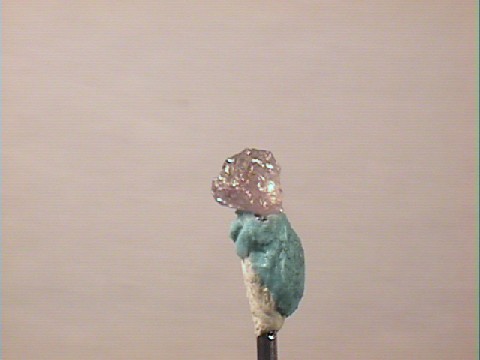
ALEXANDRITE
Specimen alx-26
$ 40.00
Dims: 4mm x 4mm x 2mm
Wt:
Minas Gerais, Brazil
This near-gem-quality fragment of alexandrite exhibits very good color change, although from a pale purplish-brown in room lighting to an excellent green in sunlight. It is more translucent than transparent, largely due to a brown inclusion. Still, this could be faceted into a small gemstone.
 Amethyst Galleries' Mineral Gallery MINERALS |

ALEXANDRITE specimen alx-1
$ 120.00
$ 120.00
Dims: 3/4"x 3/4"x1/2"
Wt: 0.5 oz. w/ box
Masauingo, Zimbabwe
Zimbabwe is not well-known for its Alexandrite production, but from the looks of this specimen, I think that they have a pretty good thing going. Though the crystals are incomplete, they rest on a more or less pure Alexandrite base and are clear enough to show a noticeable color change in bright incandescent light. I've seen some gems cut from some high-quality material from this locality-- it shows a poor red in incandescent light, and a splendid deep green(it resembles tsavorite) in daylight.

alx-1 ($120.00)
Masauingo, Zimbabwe

ALEXANDRITE specimen alx-2
$ 90.00
$ 90.00
Dims: 1/2"x 1/2"x1/2"
Wt: 0.3 oz. w/ box
Masauingo, Zimbabwe
One of our two specimens of Zimbabwe Alexandrite, this is our smaller specimen. It does not have the crystalline structures of the larger specimen, but still shows some color change in a halogen light. If I am not mistaken, there is a large partial crystal whose faces are covered with a layer of Mica, with which Alexandrite is often found. I would imagine that one could use a dilute hydrofluoric acid to remove the mica without damaging the "crystal."

alx-2 ($ 90.00)
Masauingo, Zimbabwe

ALEXANDRITE specimen alx-3
$ 140.00
$ 140.00
Dims: 0.9" x 0.6" x 0.5"(2.3 x 1.5 x 1.3 cm)
Wt: 5.7 g
Malachevo Mine, Ural Mountains, Sverdlosk State, Russia
We finally have been able to get some bona fide Russian Alexandrite crystals that have definite form and a noticeable color change! This particular specimen has portions of a few crystals, one of which appears to show part of a trilling. They all are a dull blue-green with very subtle hints of violet under incandescent light, have a vitreous luster, and are not quite transparent, with many internal fractures. Under sunlight, their green color becomes very intense, rivaling that of tsavorite. There are a few strange, transparent spots among the crystals that are red-violet in color and do not change to green under natural light. I don't know what this material is, as there is only a small portion of it, and it shows no crystal form. There is a bit of dark muscovite mica on one end of the specimen, which is affixed to a domed plastic thimble box. Though it doesn't have the red coloration under incandescent light that is sought after in Alexandrite, this specimen's color change is obvious, and the form that it has is quite good. Besides, it is rather difficult to get Russian material.

alx-3 ($140.00)
Malachevo Mine, Ural Mountains, Sverdlosk State, Russia
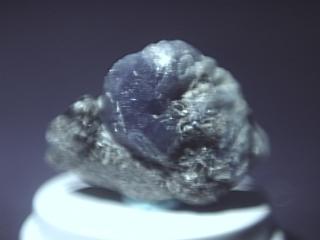
ALEXANDRITE specimen alx-4
$ 180.00
$ 180.00
Dims: 1.4" x 1.0" x 0.8"(3.6 x 2.5 x 2.0 cm)
Wt: 16.4 g
Malachevo Mine, Ural Mountains, Sverdlosk State, Russia
The Alexandrite crystal on this specimen, though incomplete, shows considerably good form and is one of the largest single pieces of Russian material that I have seen. It shows noticeable damage but has dimensions of 0.5"(1.3 cm) high and 0.8"(2.0 cm) in diameter, appearing rather conical in shape but possessing a few definite crystal faces and edges. It has a dull green-blue coloration with hints of violet under incandescent light, but sunlight will change most of its color to a deep green that is almost emerald-like. It has a vitreous luster and is translucent with small areas of transparence that are interrupted by heavy internal fracturing. There are a few smaller pieces of Alexandrite visible on the specimen, along with a red-violet material that I cannot identify- it does not have a green color under sunlight, so it is not Alexandrite. The matrix that these crystal portions rest in is made up of a dark muscovite or phlogopite mica, and the specimen is affixed to a domed plastic thimble box for display.

alx-4 ($180.00)
Malachevo Mine, Ural Mountains, Sverdlosk State, Russia

$ 350.00
Dims: 1.8" x 1.2" x 0.9"(4.6 x 3.0 x 2.3 cm)
Wt: 1.26 oz.(35.8 g)
Malachevo Mine, Ural Mountains, Sverdlosk State, Russia
Though not complete and showing considerable damage, the Alexandrite crystals on this Russian specimen make up most of its mass. The crystals each show a few faces and several edges, and have a vitreous luster. They are colored anywhere from a pale green to a pale blue to a pale violet, with some of the crystals showing each color according to angle of view. Under sunlight or fluorescent lighting, however, these crystals all take on a beautiful green color that is a bit bluer than emerald-green. All are translucent, but a few crystals show surprising transparence in areas! The Alexandrite material is partially covered by a layer of dark muscovite or phlogopite mica. I am most impressed by this specimen- it has the finest rough Alexandrite that I have seen in my travels.

Malachevo Mine, Ural Mountains, Sverdlosk State, Russia

ALEXANDRITE specimen alx-6
$ 40.00
$ 40.00
Dims: 0.6" x 0.4" x 0.3" (1.5 x 1.0 x 0.8 cm)
Wt: 3.90 ct
Minas Gerais, Brazil
I was not sure if could call this an Alexandrite specimen at first, as it appeared to be black. However, holding it up to a bank of fluorescent lights will show a few small patches of green coloration, and holding it up against a halogen light source will show a more noticeable red-violet glow. The specimen appears to be made up of at least 3 different intersecting crystals, only one of which is complete. It has slightly rounded but definable edges and striated but flat faces that have a pearly luster. Even the complete crystal shows a considerable amount of damage. However, it is one of the least expensive examples of this gemstone that I have seen.

alx-6 ($ 40.00)
Minas Gerais, Brazil

ALEXANDRITE specimen alx-7
$ 45.00
$ 45.00
Dims: 0.4" x 0.4" x 0.2" (1.0 x 1.0 x 0.5 cm)
Wt: 4.60 ct
Minas Gerais, Brazil
This small thumbnail Alexandrite specimen has some of the best crystal form in our available stock. It consists of two flat orthorombic prismatic crystals that, together, make up a v-twin. They have excellent crystal form, with clean faces and edges, and show only a small amount of visible damage. The piece has a bright pearly luster and appears to be black and opaque under normal light. However, under a bright fluorescent light source or sunlight, one can see a green glow around the edges, and a red-violet glow is discernable when the piece is put against a halogen light. The colors are somewhat difficult to discern due to the thickness of the crystal, but it costs considerably less than the market price for a gem-quality specimen of similar size and form.

alx-7 ($ 45.00)
Minas Gerais, Brazil
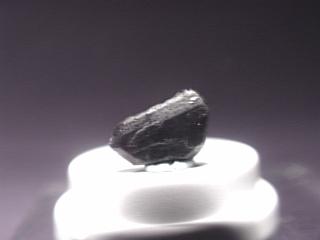
ALEXANDRITE specimen alx-8
$ 38.00
$ 38.00
Dims: 0.5" x 0.3" x 0.1" (1.3 x 0.8 x 0.3 cm)
Wt: 3.90 ct
Minas Gerais, Brazil
This particular Alexandrite specimen consists of an incomplete orthorombic crystal whose prismatic habit borders on tabular. Its intact form is relatively good, with sharp edges and flat faces that show a pearly luster. Its color appears black, and the crystal is almost completely opaque. Bright sunlight is needed to see any green coloration, and a halogen lamp is recommended to determine any of its violet-red coloration.

alx-8 ($ 38.00)
Minas Gerais, Brazil

ALEXANDRITE specimen alx-9
$ 37.00
$ 37.00
Dims: 0.4" x 0.4" x 0.1" (1.0 x 1.0 x 0.3 cm)
Wt: 3.55 ct
Minas Gerais, Brazil
This very small specimen consists of a nearly complete Alexandrite crystal; a portion of one of its corners is missing. The damage is not fresh, and may be the result of the crystal's separation from its place of formation. It has a good orthorhombic tabular form with relatively clean faces and well-defined edges, and shows a dull, waxy luster. It appears to be black-colored and opaque to all intents and purposes, and only under a bright halogen light will one be able to see a dull, red-violet glow. In sunlight, however, one can more easily make out the deep-green color change.

alx-9 ($ 37.00)
Minas Gerais, Brazil

ALEXANDRITE specimen alx-10
$ 35.00
$ 35.00
Dims: 0.4" x 0.4" x 0.1" (1.0 x 1.0 x 0.3 cm)
Wt: 3.15 ct
Minas Gerais, Brazil
This specimen consists of a twinned Alexandrite crystal. It shows definite evidence of twinning on one side, as can be seen by the striations that run along the crystals' lengths. The crystal is not quite complete and does seem to show some damage, but is still in pretty good condition. Its edges are straight and well-defined, and its faces are clean and give off a rather dull, pearly luster. To all intents and purposes, the crystal has a black coloration, but viewing it under a bright halogen light will reveal a dull, red glow. Likewise, viewing it in strong sunlight will show a green glow in some areas, though there is also still a red glow visible in one spot.


alx-10 ($ 35.00)
Minas Gerais, Brazil

ALEXANDRITE specimen alx-11
$ 75.00
$ 75.00
Dims: 0.7 x 0.7 x 0.4" (1.8 x 1.8 x 1.0 cm)
Wt: 5.0 g
Malyshevo Mine, Ekaterinberg, former Sverdlowsk State, middle Urals, Russia
This small Russian thumbnail specimen consists of 9 Alexandrite crystals that are partly embedded in a dark mica-schist matrix. These crystals do not exceed 0.2" in any dimension, and 4 of them are incomplete due to the separation of the piece from its place of origin. However, those that are intact are in excellent condition, and show no damage. Their orthorhombic form is superb, and though they are either incomplete or partly buried in the matrix, most of them are twinned and might actally have formed trillings! Their faces are clean and possess a bright vitreous luster, and their edges are well-defined. Though they are too small to work, all are gem-quality or near gem-quality, as they are transparent and surprisingly clear- most contain some veil-like inclusions and one or two small, dark inclusions, but at least one has exceptional clarity. Their color ranges from a pale greenish-brown under incandescent light to a deep, almost emerald-green coloration in sunlight. I would be sorely tempted to either work at the schist with a pick, or procure some hydrofluoric acid to try to see if the crystals really did form cyclic twins.


alx-11 ($ 75.00)
Malyshevo Mine, Ekaterinberg, former Sverdlowsk State, middle Urals, Russia

ALEXANDRITE specimen alx-12
$ 150.00
$ 150.00
Dims: 2.5 x 1.9 x 1.0" (6.4 x 4.8 x 2.5 cm)
Wt: 2.59 oz. (73.5 g)
Malyshevo Mine, Ekaterinberg, former Sverdlowsk State, middle Urals, Russia
At least 20 orthorhombic prismatic Alexandrite crystals lie partly embedded in the mica schist matrix of this small hand specimen. These crystals range in diameter from a few millimeters to 0.4" (1.0 cm) and are generally in good condition, as only the most exposed crystal shows any visible human-induced damage. Many of these are still too deeply embedded to effectively study their form, but those that are exposed tend to show discernable, though often warped, forms. Some, however, show excellent form and are obviously twinned. I cannot be certain due to their intergrowth with their base, but a few of these my be cyclic twins. Their color is somewhat of a greenish-brown in incandescent light, but changes to a deep forest-green under fluorescent lighting. There is a good chance that other crystals are embedded in the schist host rock. I have a piece that I am working on at home with a steel dental probe.


alx-12 ($150.00)
Malyshevo Mine, Ekaterinberg, former Sverdlowsk State, middle Urals, Russia
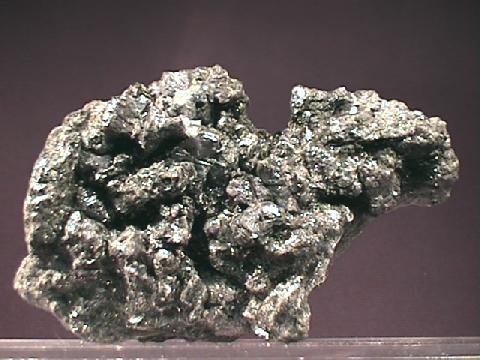
$ 750.00
Dims: 5.0 x 3.3 x 2.0" (12.7 x 8.4 x 5.1 cm)
Wt: 1 lb., 1.8 oz. (506 g)
Malyshevo Mine, Ekaterinberg, former Sverdlowsk State, middle Urals, Russia
Counting all of the Alexandrite crystals that are embedded in the host rock of this hand specimen would take too much of my time. There are at least 50 that are visible, and I would guess that many more are embedded in the schist matrix. They are generally in excellent condition, as only 3 or 4 are damaged or broken, and the largest of these has visible dimensions of 0.5 x 0.4 x 0.2" (1.3 x 1.0 x 0.5 cm). Though almost all of the crystals are either intergrown with each other or mostly obscured by matrix, several have noticeable and reasonably good orthorhombic prismatic or tabular form, with moderately well-defined edges and clean faces that possess a pearly-to-vitreous luster. One of the crystals, though broken, has even formed a cyclic twin that is at least 75% complete, and may be totally complete (see the close-up image). All have a deep forest-to-emerald-green coloration in fluorescent light or sunlight that changes to a dull red-violet or even red-brown coloration under incandescent light. Opposite the main formation of crystals are several smaller Alexandrites that are sticking out of the matrix- I believe that there are larger crystals underneath these.


Malyshevo Mine, Ekaterinberg, former Sverdlowsk State, middle Urals, Russia

ALEXANDRITE specimen alx-14
$ 27.00
$ 27.00
Dims: 0.4 x 0.4 x 0.1" (1.0 x 1.0 x 0.3 cm)
Wt: 1.90 ct
Minas Gerais, Brazil
This tiny specimen consists of a single Alexandrite "v-twin". These crystals do not exceed 0.4" (9 mm) in length, and both are in very good condition, though their collective base does show some noticeable damage. Both have good orthorhombic prismatic form, with well-defined edges and clean faces that possess a rather dull, pearly-to-waxy luster. There is some interference, however, that is caused by part of another crystal that is slightly intergrown between the two terminations. The Alexandrite appears to be black and opaque under normal light, and a bright halogen light is needed to see the red-violet color within. Likewise, sunlight is needed to see the expected green coloration. There is no host rock present.

alx-14 ($ 27.00)
Minas Gerais, Brazil

$ 96.00
Dims: 0.8 x 0.7 x 0.4" (2,1 x 1.7 x 1.1 cm)
Wt: 3 g
Carnaiba Mine, Pindobassu, Bahia, Brazil
This thumbnail specimen consists of a few intergrown Alexandrite crystals. These crystals are in very good condition, showing no fresh damage, and have a good orthorhombic bladed form. Under normal indoor light, the crystals appear to be nearly black in color and opaque. It is only under a very bright incandescent light or under sunlight that one can see a rather faint translucence. Under the incandescent light, the crystals have a dull, red-violet color, and under sunlight, their color is a deep green. Their luster ranges from waxy to greasy. There is no base or host material present, and the piece is affixed to a flat acrylic base with a removable putty.


Carnaiba Mine, Pindobassu, Bahia, Brazil

ALEXANDRITE specimen alx-16
$ 60.00
$ 60.00
Dims: 1.3 x 1.1 x 0.7" (3.4 x 2.9 x 1.8 cm)
Wt: 21 g
Malyshevo Mine, Ekaterinberg, former Sverdlowsk State, middle Urals, Russia
This large thumbnail specimen consists of two pseudohexagonal Alexandrite crystals extending from a schist matrix. The larger crystal has dimensions of 0.4 x 0.3 x 0.1" (1.0 x 0.7 x 0.3 cm), and the smaller measures about 0.1" (3 mm) in each dimension- both are damaged, though the larger crystal is much more complete. Only the large crystal is complete enough to show its crystal form, which appears to be good. Under a bright halogen light, it appears to have a patchy violet color, but under fluorescent light, it is forest-green. It is transparent and dimly clear, containing many internal flaws and some inclusions, and has a pearly luster. It is possible that there are other small crystals buried in the matrix.


alx-16 ($ 60.00)
Malyshevo Mine, Ekaterinberg, former Sverdlowsk State, middle Urals, Russia
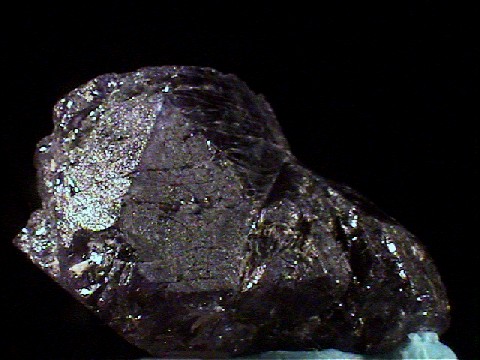
ALEXANDRITE specimen alx-17
$ 165.00
$ 165.00
Dims: 0.9 x 0.6 x 0.6" (2.3 x 1.5 x 1.4 cm)
Wt: (9 g)
South Africa
Two intergrown Alexandrite crystals make up this thumbnail specimen. These crystals are in good condition, showing moderate damage, and the larger of the two has dimensions of 0.6 x 0.6 x 0.5" (1.6 x 1.5 x 1.2 cm). Their orthorhombic form is reasonably good, as both are incomplete and intergrown, but there appears to be some twinning. Most of the Alexandrite has a dark, nearly black coloration, but much green coloration is visible under fluorescent light, and some is still visible under incandescent light. There is no other material or host rock present.


alx-17 ($165.00)
South Africa

ALEXANDRITE specimen alx-18
$ 135.00
$ 135.00
Dims: 0.8 x 0.6 x 0.4" (2.1 x 1.5 x 1.1 cm)
Wt: 6 g
South Africa
This small thumbnail piece consists of many small, heavily-intergrown Alexandrite crystals. The largest of these does not appear to exceed 0.5" (1.3 cm) in diameter, and most show some damage, though much of it is old. Their orthorhombic form is definable, but none are complete due to their damage and intergrowth. They have a pearly-to-vitreous luster and appear to be essentially black, though green coloration can be seen under both fluorescent and bright incandescent light. Several nearly microscopic mica platelets are scattered on the piece, but there is no base or host rock present.


alx-18 ($135.00)
South Africa

ALEXANDRITE specimen alx-19
$ 150.00
$ 150.00
Dims: (largest piece) 0.2 x 0.2 x 0.1" (5 x 4 x 2 cm)
Wt: >1 g (total weight)
Minas Gerais, Brazil
Seven Alexandrite partial and complete crystals comprise this essential thumbnail specimen. Though four of the seven appear to be formless shards of crystals, three pieces appear to have some crystal form, and the largest piece is a complete crystal. This largest piece is in excellent condition and has excellent pseudohexagonal form, suggesting cyclic twinning. In natural light, all have a blue-green color, though all except the largest show a brown tinge. Under incandescent light, all except the largest have a dull brown color; the largest piece shows a duller blue-green coloration. Their luster ranges from vitreous to greasy, depending on their level of wear.


alx-19 ($150.00)
Minas Gerais, Brazil

ALEXANDRITE specimen alx-20
$ 84.00
$ 84.00
Dims: 0.8 x 0.6 x 0.3" (2.1 x 1.6 x 0.8 cm)
Wt: 3 g
Carnaiba Mine, Pindobassu, Bahia, Brazil
A nearly complete Alexandrite cyclic twin comprises this thumbnail specimen. It is in good condition, showing what appears to be a small amount of relatively fresh damage, and shows reasonably good orthorhombic bladed form- though the cyclic twin shows some inconsistencies, it is obviously properly formed. Though its color is essentially black, one can see definite green highlights under fluorescent light that are absent under incandescent light. The crystal is opaque even under bright light, however. It has a rather dull luster that ranges from waxy to pearly. There is no host rock present, and the piece is affixed inside the included thumbnail box.
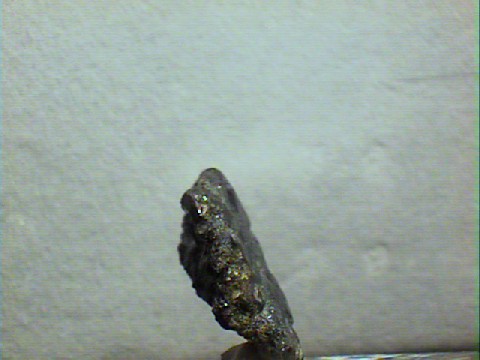

alx-20 ($ 84.00)
Carnaiba Mine, Pindobassu, Bahia, Brazil

ALEXANDRITE specimen alx-21
$ 48.00
$ 48.00
Dims: 0.9 x 0.4 x 0.3" (2.3 x 1.0 x 0.7 cm)
Wt: 2 g
Carnaiba Mine, Pindobassu, Bahia, Brazil
This thumbnail piece consists of a single Alexandrite v-twin that extends from a small schist base. The twin is in good condition, as though there is a large spot of damage on the crystal, it is old and does not severely affect the shape. Its orthorhombic form is very good- though the crystal looks like a single one on one side, one can see obvious twinning effects on the other side. It is essentially black in coloration, and under fluorescent light only a few faint green highlights are visible. A plastic thumbnail box is included.

alx-21 ($ 48.00)
Carnaiba Mine, Pindobassu, Bahia, Brazil

ALEXANDRITE specimen alx-22
$ 24.00
$ 24.00
Dims: 0.8 x 0.4 x 0.3" (2.0 x 1.0 x 0.7 cm)
Wt: 2 g
Carnaiba Mine, Pindobassu, Bahia, Brazil
Two partial Alexandrite crystals make up the bulk of this small thumbnail piece. These crystals are generally in good condition; though both show considerable damage and are incomplete, said damage occurred prior to mining. The larger of these has dimensions of 0.6 x 0.4 x 0.1" (1.5 x 1.0 x 0.3 cm), and the smaller one does not exceed 0.1" (4 mm) along any axis. The larger one shows very good, though incomplete orthorhombic form, but the smaller one is probably less than 30% complete. Both are black, showing faint green highlights when viewed under a fluorescent light. Both are opaque, needless to say, and both show a dull pearly to waxy luster. A small amount of mica schist matrix is present, and the piece is affixed inside the included thumbnail box.

alx-22 ($ 24.00)
Carnaiba Mine, Pindobassu, Bahia, Brazil

ALEXANDRITE specimen alx-23
$ 68.00
$ 68.00
Dims:0.6x0.5x0.1" (1.5x1.3x0.3 cm)
Wt: 0.4oz. (12g)w/box
Carnaiba, Bahia, Brazil
This specimen consists of a tabular partial cyclic twin crystal of the mineral chrysoberyl. There is no matrix present on this specimen. As it does display dichroism in different types of lighting, it is thus an alexandrite. I call this a partial cyclic twin because there are only two crystals. A full cyclic twin would have six crystals. This specimen displays the twin plane very well, and there is no damage present. It is attached inside a small plastic "perky" box.


alx-23 ($ 68.00)
Carnaiba, Bahia, Brazil
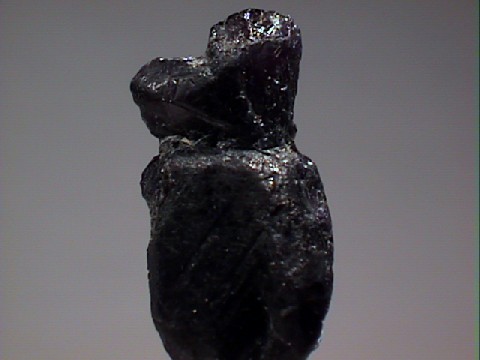
ALEXANDRITE specimen alx-30
$ 48.00
$ 48.00
Dims:0.7x0.3x0.2" (1.8x0.8x0.5 cm)
Wt: 0.4oz. (12g)w/box
Caraiba Mine, Pindobassu, Bahia, Brazil
This is a twinned crystal of alexandrite from the mines of Bahia, Brazil. There is no matrix material present on this piece. The top of the crystal shows the distinct v-shape so familiar in chrysoberyl twins. The color is quite dark, and there is no translucence visible. This specimen is undamaged, and is mounted in a small, plastic "perky" box.

alx-30 ($ 48.00)
Caraiba Mine, Pindobassu, Bahia, Brazil
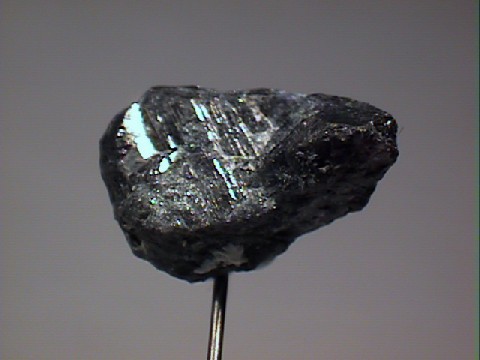
ALEXANDRITE specimen alx-31
$ 36.00
$ 36.00
Dims:0.6x0.2x0.1" (1.5x0.5x0.3 cm)
Wt: 0.4oz. (11g)w/box
Caraiba Mine, Pindobassu, Bahia, Brazil
This is another twinned crystal of chrysoberyl, variety alexandrite, from the mines of Bahia, Brazil. The twin planes on this specimen are not very obvious, and one must examine the striations on the crystal to see the twinning. This specimen is a rather dark color, with no translucence visible. There is no damage to this piece; it comes mounted in a small plastic "perky" box.

alx-31 ($ 36.00)
Caraiba Mine, Pindobassu, Bahia, Brazil

ALEXANDRITE specimen alx-35
$ 44.00
$ 44.00
Dims:0.7x0.5x0.1" (1.8x1.3x0.3 cm)
Wt: 0.1oz. (2g)
Caraiba Mine, Pindobassu, Bahia, Brazil
This is a small, flattened crystal of alexandrite. It is a twin crystal, although one must examine it closely to observe this. There is no matrix present on this specimen. The color tends to be rather dark, and is completely opaque. There is no damage to this specimen.

alx-35 ($ 44.00)
Caraiba Mine, Pindobassu, Bahia, Brazil

ALEXANDRITE specimen alx-32
$ 29.00
$ 29.00
Dims:0.7x0.2x0.1" (1.8x0.5x0.3 cm)
Wt: 0.4oz. (10g)w/box
Caraiba Mine, Pindobassu, Bahia, Brazil
This specimen consists of a twinned crystal of chrysoberyl, variety alexandrite. This specimen is half of the famous chrysoberyl "sixling" twin. It has been broken in half, and the other half is missing; there is no way of knowing if this were at one time a true sixling twin. The top and bottom arms of this twin crystal are more developed than the middle. The color is dark and opaque. Other than the breakage previously mentioned, there is no damage to this specimen. It comes mounted in a plastic "perky" box.

alx-32 ($ 29.00)
Caraiba Mine, Pindobassu, Bahia, Brazil
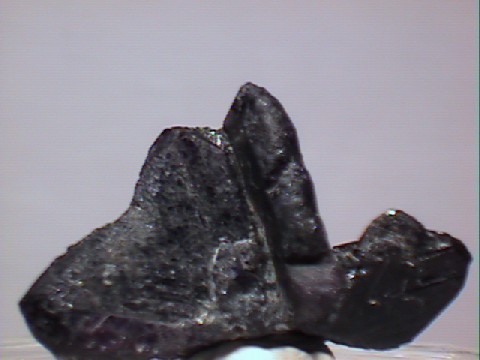
ALEXANDRITE specimen alx-33
$ 84.00
$ 84.00
Dims:1.0x0.6x0.2" (2.5x1.5x0.5 cm)
Wt: 0.2oz. (5g)w/base
Caraiba Mine, Pindobassu, Bahia, Brazil
This is a cluster of 3 chrysoberyl crystals, variety alexandrite. 2 of these crystals show distinct twinning with excellent terminations. The crystal has been broken on one side, and a piece is missing. The color is very dark in this specimen. It comes with a clear acrylic base.


alx-33 ($ 84.00)
Caraiba Mine, Pindobassu, Bahia, Brazil

ALEXANDRITE specimen alx-34
$ 96.00
$ 96.00
Dims: 1.0x0.6x0.5" (2.5x1.5x1.3 cm)
Wt: 0.2oz. (6g)w/base
Caraiba Mine, Pindobassu, Bahia, Brazil
This is an intergrown cluster of chrysoberyl crystals, variety alexandrite. The top crystal may be twinned, but it is difficult to see clearly. This piece is very dark in color and completely opaque. There is damage to one side of this specimen. It comes with a clear acrylic base.


alx-34 ($ 96.00)
Caraiba Mine, Pindobassu, Bahia, Brazil

$1200.00
Dims: 2.13x1.50x1.08" (5.4x3.8x2.75 cm)
Wt: 2.63 oz. (74.4g)
Malyshevo Mine, Ekaterinberg, Middle Urals, Russia
If you like alexandrite, you'll love this small hand specimen. It consists of dozens of tabular alexandrite crystals in a mica schist base. While some of the crystals are merely translucent, several are transparent. All of the alexandrite crystals show good color change, green under fluorescent or sunlight and bluish-gray under incandescent light (not the most desirable purple color). Many of the crystals are damaged, as this specimen likely filled a cavity in the host rock, and the tips of all of the taller crystals were in contact with the host or were damaged during removal. The specimen could possibly be "improved" by removing more schist, although there is a risk of further damaging the specimen or even of some crystals falling out. The tranparent crystals all have inclusions or internal fractures that spoil their clarity - otherwise they would have been turned into gemstones worth 10 times more and would not have made it to our site.


Malyshevo Mine, Ekaterinberg, Middle Urals, Russia

ALEXANDRITE specimen alx-37
$ 115.00
$ 115.00
Dims: 0.94x0.71x0.35" (2.4x1.8x0.9 cm)
Wt: 25 ct. (5.0g)
Malyshevo Mine, Ekaterinberg, Middle Urals, Russia
This is an excellent thumbnail specimen of alexandrite. It is a cluster of crystals, three of which have natural terminations, and one of which is excellent in form. The best crystal would be transparent and gemmy, except for numerous internal fractures which preserved it from the gem cutters and allowed us to appreciate it. The color change is excellent, although only one tiny crystal has the most desirable purple to green transition. There are several areas of a mica crystals on the specimen, the base of which is a mica schist.


alx-37 ($115.00)
Malyshevo Mine, Ekaterinberg, Middle Urals, Russia

ALEXANDRITE specimen alx-24
$ 50.00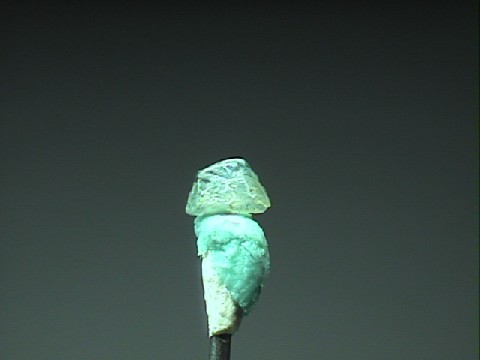
$ 50.00
Dims: 5.0mm x 3.0mm x 2.5mm
Wt:
Minas Gerais, Brazil
This tiny specimen of alexandrite is a gem quality chip - a fragment of a crystal that has a high enough quality and clarity that it could be turned into an excellent gem. It does have very good color change, and while there are visible internal fractures and one surface is a bit rough (and cloudy), the bulk of the chip is transparent.


alx-24 ($ 50.00)
Minas Gerais, Brazil

ALEXANDRITE specimen alx-25
$ 45.00
$ 45.00
Dims: 5.0mm x 4.0mm x 2.0mm
Wt:
Minas Gerais, Brazil
This gem-quality chip of alexandrite shows no hint of crystal structure, and has very good color change. Under normal room (incandescent) lighting, it appears nearly colorless, changing to a distinct green under fluorescent light. This chip is noticable pleochroic, appearing more green when viewed along its long axis. There are two internal fractures that intersect at right angles, forming a cross from one viewing angle.


alx-25 ($ 45.00)
Minas Gerais, Brazil

ALEXANDRITE specimen alx-26
$ 40.00
$ 40.00
Dims: 4mm x 4mm x 2mm
Wt:
Minas Gerais, Brazil
This near-gem-quality fragment of alexandrite exhibits very good color change, although from a pale purplish-brown in room lighting to an excellent green in sunlight. It is more translucent than transparent, largely due to a brown inclusion. Still, this could be faceted into a small gemstone.

alx-26 ($ 40.00)
Minas Gerais, Brazil
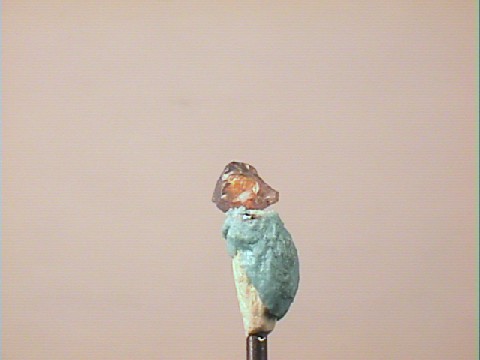
ALEXANDRITE specimen alx-27
$ 35.00
$ 35.00
Dims: 4mm x 2 mm x 1 mm
Wt:
Minas Gerais, Brazil
This tiny shard of alexandrite is transparent enough to be considered gem-quality. It does have minor inclusions, and it looks brown in room light, changing to an excellent pale green in sunlight. This stone is "cut-able", best to a teardrop or heart shape.

alx-27 ($ 35.00)
Minas Gerais, Brazil

ALEXANDRITE specimen alx-28
$ 30.00
$ 30.00
Dims: 3.0mm x 3.0mm x 3.0mm
Wt: 0.15 ct. (0.03g)
Minas Gerais, Brazil
This is a tiny crystal of alexandrite, looking somewhat like the tip of a crystal (mostly termination) that has been cleaved. It has a flat base, 1mm of side (roughly hexagonal), and 2mm of pyramidal termination. It has excellent color change, from green (with hints of blue) in sunlight, to purple under incandescent lighting. It is translucent, and has a brown inclusion preventing its use as a gemstone.

alx-28 ($ 30.00)
Minas Gerais, Brazil
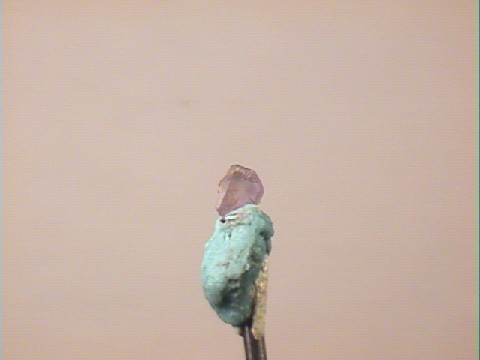
ALEXANDRITE specimen alx-29
$ 25.00
$ 25.00
Dims: 3.2mm x 3.2mm x 1.2mm
Wt: 0.10 ct. (0.02g)
Minas Gerais, Brazil
This is a fragment (shard) of an alexandrite crystal. It has excellent color change from green (hints of blue) to pale purple. Although the surface is slightly rough and weathered, the crystal is quite transparent.

alx-29 ($ 25.00)
Minas Gerais, Brazil

ALEXANDRITE specimen alx-38
$ 37.00
$ 37.00
Dims: 0.81x0.69x0.45" (2.07x1.76x1.13cm)
Wt: 25.5ct (5.1g)
Misvingo, Zimbabwe
This is a cluster of nearly opaque alexandrite crystals. They are just barely translucent (enough to show a color change from green to nearly black). Most of the crystals are highly distorted, with rounded edges or missing terminations, although there are a number of prismatic crystals with at least a few really good faces. There are enough decent crystals that this is clearly a cluster of intergrown alexandrite crystals, even to the unaided eye.


alx-38 ($ 37.00)
Misvingo, Zimbabwe
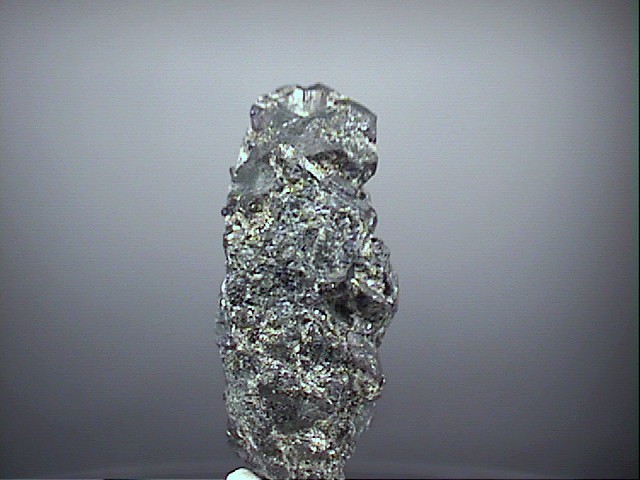
ALEXANDRITE specimen alx-39
$ 45.00
$ 45.00
Dims: 1.82x0.86x0.63" (4.62x2.18x1.59cm)
Wt: 0.79oz (22.5g)
Misvingo, Zimbabwe
This is a cluster of intergrown alexandrite crystals. While most of the crystals are incomplete and damaged, there are enough good faces to identify a dozens of crystals. Some of the crystals are transparent, if only slightly, and a loupe reveals bands of opaque black and transparent green alexandrite. There is a lot of color change, but I cannot say it is "good" color change, because I do not see a change to purple. Rather, it looks black with a little green in incandescent light, and quite green in sunlight.


alx-39 ($ 45.00)
Misvingo, Zimbabwe

ALEXANDRITE specimen alx-40
$ 90.00
$ 90.00
dims mm=37.60x31.23x15.83
wt g=21.6
Misvingo, Zimbabwe
Although quite dark (nearly black), this is a very nice specimen of alexandrite. Some of the crystals are transparent enough that the appear purple when illuminated from behind with incandescent light. They also show very good color change, appearing green in sunlight. The entire mass is a cluster of tightly intergrown crystals, a few of which have excellent form. Of course, if it was transparent enough to be gem quality, it would have been cut into dozens of gemstones, and never would have graced our site.


alx-40 ($ 90.00)
Misvingo, Zimbabwe